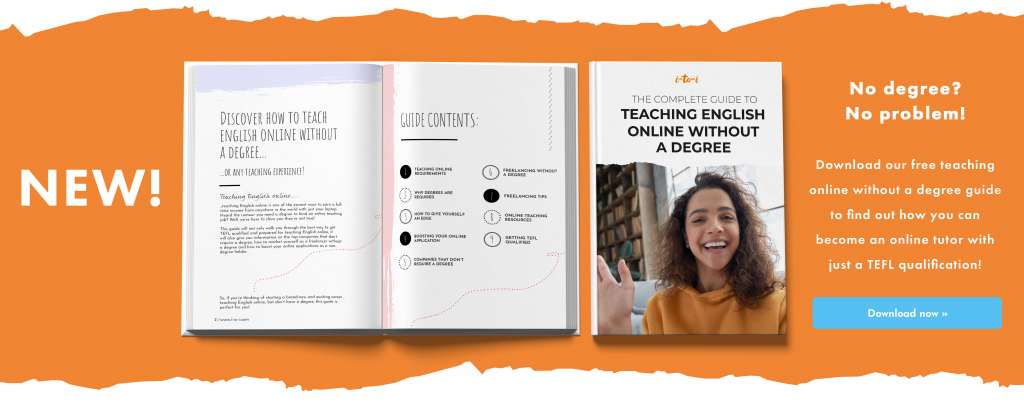Have you been hearing the word ‘eliciting’ a lot? Wondering what it means and why it’s so important? Don’t worry, we can explain!
What is ‘eliciting’?
When it’s used in relation to teaching, ‘eliciting’ (or elicitation) simply refers to a group of techniques that teachers use to get their students to provide information. So, instead of providing the information all the time, the teacher would give some kind of stimulus or prompt in order to draw out a response from the student/motivate them to provide the answer. E.g. If the teacher wants the student to say the word “aeroplane” they might say “this flies in the air….a pilot uses it to take us from country to country….it has metal wings” etc. to prompt the correct response.
Why is it important?
There are lots of reasons why eliciting is an important thing to include in your lessons, but our top 5 are:
- It makes the lesson learner-centred rather than teacher-centred.
- It improves information retention, as students learn to link old and new information and continue to practice the things they have learned
- Your students will experience faster progress of their language abilities, as they are practicing more, which will increase their confidence. This will make them more likely to continue to use and practice their new language skills outside of the classroom!
- Your students are more likely to be engaged, as they are actively doing something rather than passively listening to the teacher.
- You can find out what your students do/don’t know, so you can base your lessons around this and build on their knowledge – making lessons more relevant for them and therefore more engaging.
NB: It can be harder to find out what they know through other methods, as you’ll often find students will reply “Yes” to the questions “Do you understand?” “Do you know?”, to avoid feeling embarrassed in front of classmates or the teacher, regardless of whether they do actually know or understand (so, it can be difficult to know their true level of ability).
What are some EFL eliciting techniques?
We’ve already demonstrated one technique for eliciting vocabulary – providing clues to direct students to the word/words you’re looking for (aka: Match the word to the definition) – but there are lots of other techniques out there, including:
Synonyms
Making a statement and then asking students to paraphrase using synonyms of the words you used. This is best for older or more advanced students. E.g. Teacher: “I enjoy visiting places with lots of books”, Student: “She likes going to libraries”.
Flashcards or Pictures
Best for younger learners, presenting them with flashcards or pictures of the vocabulary you’re looking for and asking them to tell you what it is. They can also be used to turn the exercise into a game, to keep learners engaged. For some game ideas check out the Teach This website.
Mind Maps or Word Clusters
Start with a ‘topic word’ and then have students add all the different words related to that topic. E.g. Topic word = ‘Nature’, so related words might be ‘mountains’, ‘soil’, ‘rivers’, ‘beach’, ‘woods’ etc.
Modelling
Where the teacher will model the structure they are looking for and then prompt students to develop their own version. E.g. Teacher: “Do you like dogs?”, Student: “Yes”, Teacher: “Do you like sharks?”, Student: “No”, Teacher: “What’s the question? Ask me.” (Prompting the student to copy the structure the teacher has demonstrated and replace the last word with a different animal word that they have learnt).
Multiple Choice
Good for lower-level abilities, as you can give the students multiple possible answers and ask them to select the correct one. E.g. Students have the following statements: “Wolves usually have green fur”, “Wolves usually have grey fur”, “Wolves usually have pink fur”, Teacher then asks: “What colour fur do wolves usually have?” and students have to select/speak the correct answer.
Stories
Using stories/situational dialogues (either in the form of a listening or reading exercise) to elicit information from the students, once they have listened to, or read, the story. E.g. Listening to the story “The Gruffalo” and then asking questions like “Who was walking in the wood?”, “Who did the mouse meet first?”, “What colour were The Gruffalo’s eyes?” etc.
And this is just a selection! For more ways to bring eliciting into your TEFL classroom, see our TEFL courses.
What are some Top Tips for eliciting?
It can take a while to develop your eliciting techniques, so it’s definitely something to start ASAP with your students! Our top tips, when you’re just getting started, are:
- Make sure you select the appropriate technique for the level of your students’ language ability – making something too hard or too easy won’t help your students to progress.
- Be patient and don’t be afraid of a bit of silence – sometimes students need a bit more time to answer!
- If you have mixed ability classes, you could put students into groups and make the higher- level students in each group the ‘mini teachers’ – getting them to elicit the information from their lower-ability classmates.
- Follow up with Concept Checking Questions – got the response you were looking for from one of your students? That’s great! But you need to make sure the rest of the class is at the same level of understanding as that student, before you move on. This can be assessed using concept checking questions.
The best way to become an eliciting expert is to take a TEFL course, as it will provide all the information you need to feel confident using these techniques in your classroom (whether online or in-person). Still need to get qualified? Check out our range of courses, or take our quick course-matching quiz, to find out which one is your perfect fit!
Would you prefer to speak to someone before you book? No problem! Arrange for a free call back from one of our friendly TEFL experts, and they’ll be happy to help.





